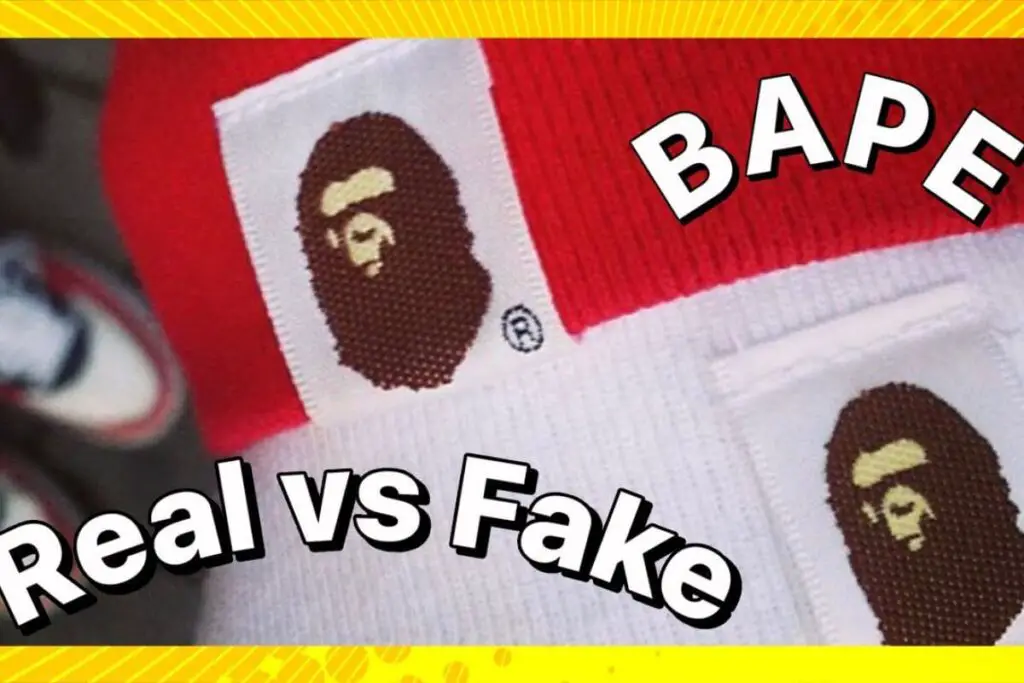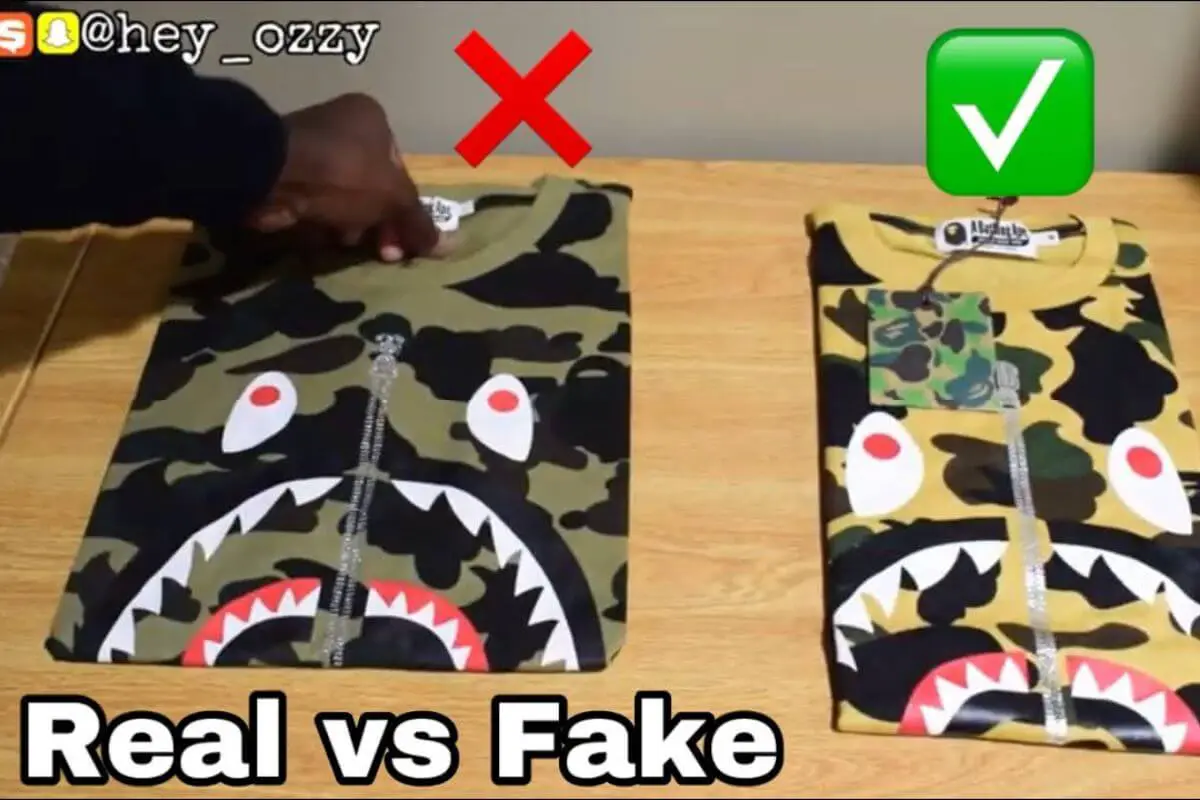In the world of streetwear fashion, few names resonate as loudly as Bathing Ape, or BAPE, a Japanese brand founded by Nigo in 1993. Renowned for its bold camo patterns and iconic ape logo, BAPE has become a global phenomenon. However, the popularity of BAPE has also given rise to a proliferation of counterfeit products flooding the market. In this comprehensive guide, we will dissect the world of BAPE, equipping you with the knowledge to distinguish genuine BAPE items from their counterfeit counterparts. Whether you’re an avid collector or a newcomer to the streetwear scene, this guide will help you navigate the often murky waters of real vs. fake BAPE.
Understanding BAPE’s Appeal
To grasp the significance of differentiating real BAPE from counterfeit imitations, it’s essential to first appreciate what makes BAPE such an iconic and sought-after brand in the world of streetwear fashion.

1. Unique and Striking Designs:
- BAPE is celebrated for its audacious and distinctive designs, setting it apart from the sea of mundane fashion. The brand’s camo patterns, including the iconic “1st Camo” and “ABC Camo,” have become legendary.
2. Impeccable Craftsmanship:
- Authentic BAPE products are the result of meticulous attention to detail and are crafted with top-notch materials. From t-shirts to outerwear, the quality is consistently outstanding.
3. Limited Editions and Exclusivity:
- BAPE often releases limited-edition collections and collaborations. This approach amplifies the exclusivity of their products, creating a sense of urgency and desire among collectors and fashion enthusiasts.
4. A Pop Culture Phenomenon:
- BAPE’s influence extends well beyond fashion circles. It is the preferred attire of celebrities, musicians, athletes, and influencers around the world. Iconic figures like Pharrell Williams, Kanye West, and NIGO himself have proudly endorsed the brand.
5. Streetwear Legacy:
- BAPE is a pioneer in the streetwear movement, and its designs have consistently pushed the boundaries of urban fashion. The brand’s unmistakable ape logo and camouflage patterns have become emblematic of street culture.
These factors contribute to the enduring appeal of BAPE, making it not just a fashion brand but a cultural phenomenon. However, this very appeal has led to the proliferation of counterfeit BAPE products, which can make it challenging to distinguish the real deal from imitation. In the next sections, we will explore the key elements that help identify authentic BAPE items and guard against the disappointment of falling for counterfeit merchandise.
Spotting Authentic BAPE Products
In a market flooded with both authentic BAPE products and their counterfeit counterparts, distinguishing real from fake is an art in itself. To safeguard your investment and keep your streetwear collection genuine, here’s a comprehensive guide on how to spot authentic BAPE items.
1. Price and Bargain Alert:
- Authentic BAPE: Real BAPE products come with a price tag that reflects their quality and exclusivity. If a deal appears too good to be true, it likely is.
- Counterfeit: Counterfeit BAPE items are often priced significantly lower to attract budget-conscious buyers.
2. Inspect Labels and Tags:
- Authentic BAPE: Genuine BAPE items bear meticulously crafted labels, tags, and stitching. Pay close attention to the quality and the absence of irregularities.
- Counterfeit: Counterfeit products frequently exhibit flaws in the labels, tags, and stitching. This may include poor printing or misspelled words.
3. Examine Zippers and Hardware:
- Authentic BAPE: Authentic items feature high-quality zippers and hardware, often bearing the APE logo. These zippers should operate smoothly without issues.
- Counterfeit: Counterfeit products may compromise on the quality of zippers and hardware, leading to potential breakage or malfunction.
4. Scrutinize Stitching and Seams:
- Authentic BAPE: Genuine items showcase impeccable stitching without any loose threads or irregularities. The seams are uniformly crafted.
- Counterfeit: Counterfeit products often reveal subpar stitching with loose threads, uneven seams, and other imperfections.
5. Assess the Packaging:
- Authentic BAPE: Authentic BAPE products come with meticulously designed packaging, complete with official tags and labels.
- Counterfeit: Counterfeit packaging may be poorly made, featuring inconsistencies in tags and labels.
6. Authenticate the Tags:
- Authentic BAPE: BAPE items come with unique tags that vary by collection. Familiarize yourself with these tags to distinguish genuine items.
- Counterfeit: Counterfeit tags are typically generic and lack the unique characteristics of authentic BAPE tags.
7. Trust the Seller:
- Authentic BAPE: The safest way to acquire real BAPE products is to purchase from authorized BAPE retailers or the official BAPE website.
- Counterfeit: Be cautious of sellers on third-party marketplaces, social media, or unverified sources. A lack of credibility can be a red flag.
By employing these guidelines and arming yourself with knowledge, you can significantly reduce the risk of inadvertently purchasing counterfeit BAPE items. While the allure of BAPE’s unique designs and streetwear prestige is undeniable, the satisfaction of owning genuine merchandise is incomparable.
Final Thoughts
As we conclude this exploration of distinguishing real from fake BAPE products, it’s important to emphasize the significance of making informed choices when navigating the world of streetwear fashion. BAPE’s iconic designs and streetwear prestige have cemented its place as a cultural phenomenon, attracting a dedicated global following. Yet, this popularity has also given rise to counterfeit BAPE items that can leave buyers disillusioned.
Understanding the appeal of BAPE is the first step towards discerning genuine items from imitations. BAPE’s unique designs, quality craftsmanship, limited editions, and profound influence on pop culture all contribute to its enduring charm. Recognizing the appeal of the brand not only enhances your appreciation for genuine BAPE products but also underscores the importance of authenticity.
In the world of streetwear, spotting authentic BAPE products is an art that can protect your investment and collection. Price, labeling, hardware, stitching, packaging, and the reputation of the seller are all vital factors to consider when verifying the authenticity of your BAPE purchases.
Purchasing genuine BAPE items is more than just a fashion statement; it’s a commitment to quality, creativity, and a celebration of the brand’s heritage. It’s about proudly owning a piece of streetwear history that has left an indelible mark on the fashion landscape.
As you navigate the world of BAPE, remember that the value of genuine items extends beyond the material. It represents an appreciation for design, craftsmanship, and the culture that defines the brand. By staying informed and making discerning choices, you can ensure that your BAPE collection is a true reflection of your passion for authentic streetwear fashion.
FAQs
1. What is BAPE, and why is it popular?
BAPE is a Japanese streetwear brand renowned for its unique designs, quality, and pop culture influence.
2. Are there many counterfeit BAPE products in the market?
Yes, the popularity of BAPE has led to a proliferation of counterfeit items.
3. Why is it important to spot fake BAPE products?
Counterfeit items lack the quality and authenticity of genuine BAPE products, potentially leading to disappointment and financial loss.
4. What is the best way to verify if a BAPE item is real?
Examining details like price, labeling, stitching, and the reputation of the seller is crucial.
5. Can you find authentic BAPE products at significantly lower prices?
Authentic BAPE products are not sold at suspiciously low prices, so be cautious of such deals.
6. What kind of labels and tags should I look for in authentic BAPE products?
Genuine BAPE products have well-crafted labels and tags, free from irregularities.
7. Are there specific signs of counterfeit labeling?
Counterfeit labeling may exhibit stitching flaws, poor printing, or misspelled words.
8. Do authentic BAPE products have special zippers and hardware?
Authentic items feature high-quality zippers and hardware with the APE logo.
9. Are there common issues with counterfeit zippers and hardware?
Counterfeit products often use cheaper zippers and hardware that may break or malfunction easily.
10. What should I look for in terms of stitching and seams for real BAPE items?
Genuine items showcase impeccable stitching without any loose threads or irregularities.
11. What are the common signs of counterfeit stitching?
Counterfeit products frequently exhibit subpar stitching with loose threads and uneven seams.
12. How can I recognize authentic packaging for BAPE products?
Authentic BAPE products come with well-designed packaging, complete with official tags and labels.
13. What issues might counterfeit packaging have?
Counterfeit packaging may be poorly made, with inconsistencies in the tags and labels.
14. What are the unique characteristics of BAPE tags?
BAPE items come with unique tags that vary by collection. Familiarize yourself with these to spot genuine items.
15. How can you distinguish counterfeit tags from real ones?
Counterfeit tags are often generic and lack the unique characteristics of authentic BAPE tags.
16. Is it safe to purchase BAPE products from third-party sellers or social media platforms?
Be cautious when buying from unverified sellers, as they may not be credible sources for genuine BAPE products.
17. Can counterfeit BAPE products be sold on popular e-commerce platforms?
Yes, counterfeit items can sometimes be found on third-party marketplaces.
18. Are there any official BAPE retailers where I can confidently purchase genuine items?
Purchase from authorized BAPE retailers or the official BAPE website to ensure authenticity.
19. Are there common traits of genuine BAPE products that I should remember?
Genuine BAPE items exhibit consistent quality, with no irregularities in labels, tags, or stitching.
20. What is the ultimate benefit of owning authentic BAPE products?
Owning genuine BAPE items reflects your commitment to quality, creativity, and an appreciation of authentic streetwear fashion.



